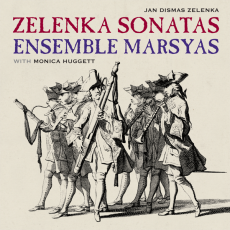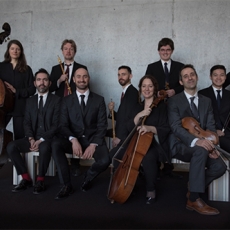Ensemble Marsyas - Zelenka Sonatas - SA-CD.net
This wonderful set of Ensemble Sonatas by Jan Dismas Zelenka (1679-1745) comes to us courtesy of Linn Records and an all-star band that calls itself Ensemble Marsyas. Not that it matters, but Marsyas was the satyr in Greek mythology who so excelled at playing reeds (the aulos, I presume) that he challenged Apollo to a cutting contest. Linn's Ensemble Marsyas formed itself in Edinburgh in 2011, and it consists of three young double-reed players and a phenomenal "rhythm section" of theorbo, keyboards, and bass violone. Specifically, these are Josep Domènech Lafont, principal oboe of Concerto Köln; Molly Marsh, principal oboe with the Accademia Bizantina (Italy); and Peter Whelan, principal bassoon with the Scottish Chamber Orchestra. Their supporting peers - Thomas Dunford, theorbo; Philippe Grisvard, keyboards; and Christine Sticher, violone - appear to be just as accomplished.
For this album they are joined by celebrated early-music violinist Monica Huggett, which is a bit like having Eric Clapton agree to sit in at your guitar class's spring recital. The difference, of course, is that everyone in the room plays well. And have they excellent music at hand.
Zelenka was a Bohemian, from Lounovice. When scholarly editions of the six sonatas for two oboes and bassoon were published between 1955 and '65, the works' technical demands and singular musical style evoked widespread interest among wind players. (A similar explosion of performances of Zelenka's sacred vocal music occurred about 20 years later.) These are trio sonatas, which means they can and should be played by at least four players and possibly more. One of them is scored for violin, oboe, and bassoon, hence Huggett's involvement. On this album we get three complete sonatas and the Andante from a Simphonie à 8 Concertanti.
If you think you know Baroque music, you're in for a series of pleasant shocks. Zelenka's compositional voice is unique. He favors unusual thematic lines, fascinating contrapuntal combinations, and plenty of terror-inducing challenges for the players. It's music that both welcomes you in and gently surprises, delights, and moves you. I've gotten enormous pleasure out of listening to these over the last couple of weeks.
Balances are good, allowing the important counterpoint to be heard. The continuo players contribute to a rich accompanimental texture but never swamp the principals. (Of course, with Baroque oboes, the danger of anyone else dominating the soundstage is never that substantial!) The varied timbres of the instruments come through clearly, and the players manage a good degree of expressive control, i.e., dynamically shaping the phrases, using agogic accents, etc. Huggett plays beautifully too, providing a welcome contrast to the reeds.
Recording-wise, there's nothing much to complain about. I might have preferred a little more distance from the musicians - they're recorded so intimately that it's difficult to feel much space between them. But many listeners will find that the juicy colors more than justify getting so "up close and personal."
These pieces have been recorded several times before - e.g., Ensemble Zefiro (Auvidis Astrée), Heinz Holliger & Thomas Zehetmair (ECM), and a group of American first-chair players (Crystal). But I don't think anyone should hesitate to acquire this very attractive selection. Very nice booklet notes from Janice Stockigt of the University of Melbourne, incidentally.

